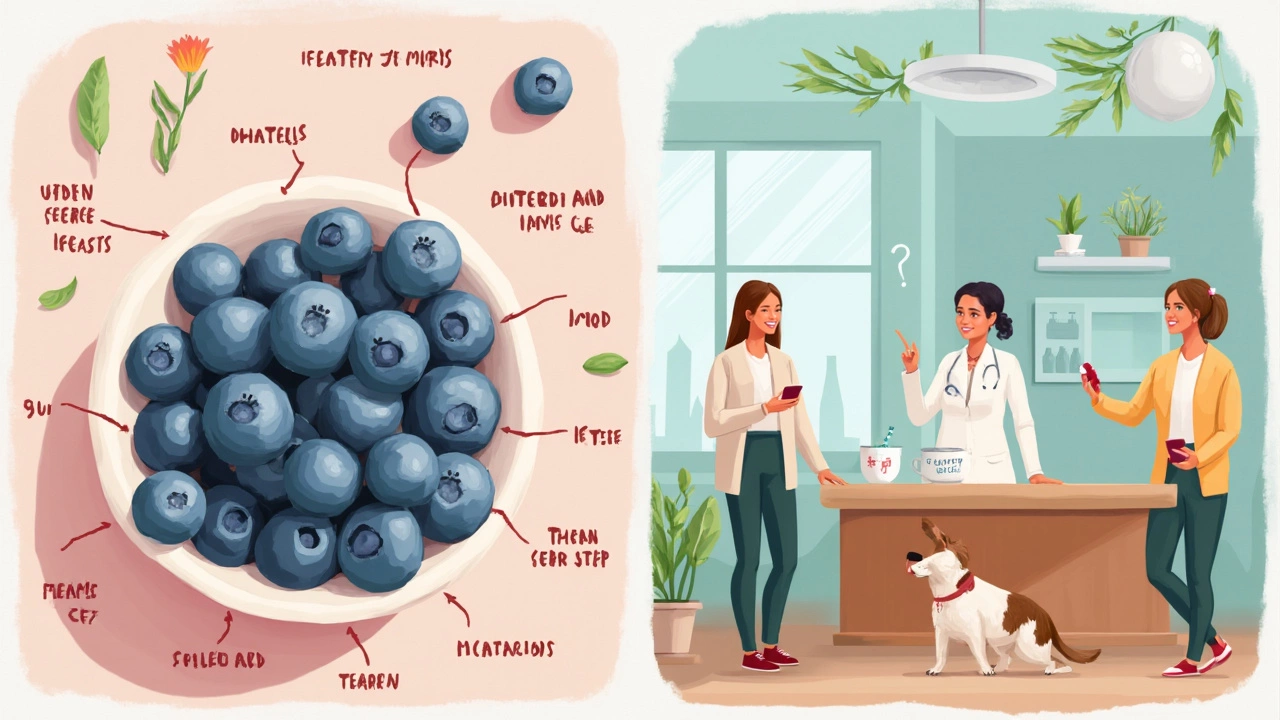Dogs seem to love stealing a few bites of whatever we're eating, and you might have wondered if those little blueberries you're snacking on are safe for your furry friend. The quick answer? Yes—blueberries are actually safe for most dogs, and they're packed with nutrients that can give your pup a healthy boost.
What's great is that you don't need to cook or prepare them in any weird way. Just wash them, and you can pop a berry or two to your dog. They're bite-sized already, making them an effortless snack—especially if your dog is a fan of something sweet and juicy without added sugar.
But before you fill your dog's bowl with fruit salad, there are a few things to keep in mind. Not every dog reacts the same way to new foods, and even healthy snacks can cause problems if your pup has a sensitive stomach or you go overboard with the portions. Some dogs love the taste and texture, while others may turn up their nose or get a bout of tummy trouble.
- Blueberries: Are They Safe for Dogs?
- Why Blueberries Make a Healthy Dog Treat
- Precautions and Possible Risks
- Easy Ways to Serve Blueberries to Your Dog
Blueberries: Are They Safe for Dogs?
If you’re worried about letting your pup snack on blueberries, you’ll be happy to know they are one of the safest fruits for dogs. Blueberries aren’t toxic to dogs, unlike grapes or raisins. That means if your dog snags a berry off the floor, there’s no emergency vet call needed.
These little berries are packed with vitamins like C and K, plus antioxidants—ingredients that pop up a lot in dog health products. Antioxidants help tackle those sneaky molecules (free radicals) that cause cell damage. In fact, some commercial dog supplements actually list blueberry extract for this reason.
Most dogs can eat blueberries raw, frozen, or even blended into food. But it’s smart to start slow if it’s their first time. Some small dogs might have trouble swallowing a whole berry (choking risk), especially if they really inhale their treats. If that’s your dog, just squish the berry or cut it in half.
Curious how much is OK? Small dogs do fine with 2-3 at a time, while larger breeds can enjoy a small handful. Too many, though, can upset their stomach—even with foods as healthy as blueberries. Here’s a quick reference:
| Dog Size | Suggested Amount |
|---|---|
| Toy/Small | 2-3 berries |
| Medium | 4-6 berries |
| Large | Small handful (8-10) |
Always wash blueberries first to rinse off pesticides or dirt. Avoid blueberry muffins, pies, or anything loaded with sugar or artificial sweeteners like xylitol—those are not safe. Stick to plain, fresh blueberries for your dog to keep things healthy.
Why Blueberries Make a Healthy Dog Treat
You’re not the only one who benefits from blueberries—these tiny berries are a powerhouse for dog health too. They’re full of antioxidants, vitamins, and fiber that can help keep your pup in good shape. Antioxidants help fight free radicals, which are sneaky molecules that speed up aging and mess with your dog’s cells. That’s why so many modern dog supplements use blueberry as a star ingredient.
What makes blueberries stand out among safe fruits for dogs is how much they support the immune system. Blueberries have vitamin C and vitamin K, which help your dog’s body fight off nasties and keep blood clotting normal. They also have manganese, which helps with bone health and metabolism. Plus, fiber helps support your dog’s digestion and keeps their bathroom trips regular.
Check out what’s inside a single 100-gram serving of blueberries (about a handful):
| Nutrient | Amount |
|---|---|
| Vitamin C | ~9.7 mg |
| Vitamin K | ~19.3 mcg |
| Fiber | 2.4 g |
| Manganese | 0.34 mg |
| Calories | ~57 kcal |
Low calories mean blueberries make a smart alternative to processed treats, especially for pups that need to watch their weight. They’re not loaded with sugar like some fruits, so you can sneak a few in without guilt.
- Good for senior dogs: The antioxidants and vitamins may help aging dogs keep their brains sharp.
- Training treats: Their tiny size is perfect for positive reinforcement without adding many calories.
- Gentle for sensitive dogs: Most pups handle blueberries without issues, but always start with small amounts.
It’s easy to see why blueberries are showing up in a lot more dog health recipes and snacks these days. If you’re picky about what goes in your dog's mouth, there aren’t many treats out there as naturally healthy as these.

Precautions and Possible Risks
Even though blueberries are safe for most dogs, they aren't risk-free. Giving too many at once is the biggest mistake. Blueberries are rich in fiber, and if your pup eats a bunch in one go, you might end up dealing with diarrhea or a gassy belly. Moderation is the golden rule here.
Size can be a surprise risk, especially for tiny dogs. Blueberries may seem cute and harmless, but they can be a choking hazard if gulped down. If you have a small breed or a dog that eats way too fast, think about squishing the berries or cutting them up before serving.
Allergies are rare, but some dogs have food sensitivities just like people. The first time you offer blueberries, start with one or two and watch for any reaction—itchiness, ear shaking, paw licking, or an upset stomach. If things look off, skip the berries and stick to what you know works for your dog.
It's also a good idea to stick with fresh or frozen blueberries only. Avoid anything canned, in syrup, or mixed into muffins or granola bars. Those foods often have added sugar, artificial sweeteners (especially xylitol, which is toxic to dogs), or other ingredients that can do more harm than good.
Here's a quick look at the main concerns when it comes to dogs and blueberries:
- Too many blueberries can upset your dog's stomach due to their fiber content.
- Choking risk, especially for small breeds or dogs who gulp food.
- Rare possibility of allergy or sensitivity.
- Avoid processed products (syrup, baked goods) that can have harmful extras.
To keep things safe, use blueberries as occasional treats, not the main event. This way, your pup can enjoy the perks without any side effects. If you're thinking about adding blueberries to your dog's food every day for health reasons or as dog health supplements, it's smart to check in with your vet first—just to be sure your dog's on the right track.
Easy Ways to Serve Blueberries to Your Dog
Good news: dogs can enjoy blueberries in a bunch of ways, and some of them are super easy. The trick is to keep it simple and safe, especially if you're just starting out. Here’s how you can add this healthy little fruit to your dog’s routine without any stress.
- Raw and Washed: The easiest way is to offer washed, fresh blueberries as a quick treat. No need to peel or chop since they’re already small enough for most dogs to chew and safely swallow.
- Frozen Treats: Pop some blueberries in the freezer for a cooling snack. Perfect on hot days or as a crunchy extra for teething puppies. Just be sure to feed one at a time to prevent choking.
- Mix Into Food: Sprinkle a few blueberries onto your dog’s usual kibble or wet food. This adds a sweet pop and a few extra antioxidants without messing with their diet too much.
- Homemade Dog Treats: You can bake blueberries into simple DIY dog treats. Use basic, dog-safe ingredients like oats and plain yogurt. Keep it bland—skip the sugar and salt.
- Puppy Puzzle Fillers: For some mental exercise, tuck blueberries inside a treat-dispensing toy. It’s a fun way to slow down speedy eaters, too.
Don’t go overboard. Treats—including blueberries—should only take up about 10% of your dog’s daily calories. The rest should come from balanced dog food.
| Serving Size (based on dog's weight) | Max Blueberries per Day |
|---|---|
| Toy/Small Dog (<15 lbs) | 2-4 berries |
| Medium Dog (15-50 lbs) | 5-6 berries |
| Large Dog (>50 lbs) | 8-10 berries |
If you use dog supplements, check if blueberry is already listed as an ingredient. Some dog health supplements include dried blueberries for that antioxidant punch, so make sure you’re not doubling up. Also, stay away from blueberry muffins, pies, or anything with added sugar or xylitol—those are a big no for dogs.
Try different serving ideas and watch how your dog responds. If they seem excited and their belly is happy, you've got yourself a new, healthy treat in their snack mix.

